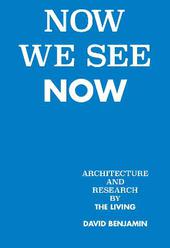
|
Now We See Now: Architecture and Research
Hardback
Main Details
| Title |
Now We See Now: Architecture and Research
|
| Authors and Contributors |
By (author) David Benjamin
|
|
By (author) Alejandro Zaera-Polo
|
| Physical Properties |
| Format:Hardback | | Pages:400 | | Dimensions(mm): Height 216,Width 152 |
|
| Category/Genre | Architecture |
|---|
| ISBN/Barcode |
9781580935074
|
| Classifications | Dewey:724.7 |
|---|
| Audience | |
|---|
| Illustrations |
500
|
|
Publishing Details |
| Publisher |
Monacelli Press
|
| Imprint |
Monacelli Press
|
| Publication Date |
8 May 2018 |
| Publication Country |
United States
|
Description
The Living- Architecture and Research chronicles the projects and findings of a firm that is charting bold new directions in generative design and other intersections of science and architecture. In the context of massive and accelerating change--in technology, science, climate, and society--the nature of architectural design is also evolving and coming to life in new ways. New York-based office The Living has developed a unique design approach that explores projects through the application of new technologies, materials, and the growing field of generative design (design that uses software to emulate nature's evolutionary processes). These methods are futuristic, even utopian, but also raw and immediate in their application of hands-on prototyping and testing through making. The Living addresses urgent issues through reframing design with today's tools. David Benjamin, founding principal of The Living, explains his methodologies through numerous projects and abundant research that are making real inroads to what is increasingly known as generative design. Benjamin executes numerous projects that demonstrate these surprising techniques, including the Princeton Embodied Computation Lab, a new building for research on next-generation design and construction technologies; Hy-Fi, a branching tower for MoMA PS1 made of a new type of biodegradable brick; and using principles of adaptive networks to prototype new structural dividers for Airbus that are nearly 50% lighter than traditional ones. The Living- Architecture and Research documents this emerging body of work and points to new directions for an evolving discipline, surveying projects at a variety of scales for a variety for clients. For an era where rapid change is the norm, The Living demonstrates how future design practices can embrace uncertainty and generate surprising solutions to tomorrow's challenges.
Author Biography
David Benjamin is founding principal of The Living and Assistant Professor at Columbia GSAPP. Benjamin's work combines research and practice focusing on the intersection of biology, computation, and design. Exploring these ideas through prototyping, Benjamin has articulated three frameworks for harnessing living organisms for architecture- bio-computing, bio-sensing, and bio-manufacturing. He and the firm have won numerous design prizes, including the Emerging Voices Award from the Architectural League, the New Practices Award from the AIA New York, the Young Architects Program Award from the Museum of Modern Art and MoMA PS1, and a Holcim Sustainability Award. Clients of The Living include Google, Nike, 3M, Airbus, BMW, the City of New York, Seoul Municipal Government, Miami Science Museum, and Bj rk. Alejandro Zaera-Polo is a scholar and founder of Alejandro Zaera-Polo & Maider Llaguno Architecture (AZPML). Kevin Slavin is a pioneer in rethinking game design and development and teaches at the MIT Media Lab. Eyal Weizman is an architect and director of the Centre for Research Architecture at Goldsmiths, University of London.
ReviewsHy-Fi--the 42-foot-tall tower of fungi-grown bricks that stood outside MoMA PS1 in 2014 - remains emblematic of New York City - based the Living, the technology- and biology-forward practice led by architect David Benjamin. Yet, Hy-Fi is hardly the firm's only project of note. Most recently, the firm designed a network of sensors in the East River (dubbed Pier 35 Eco-Park) that, if you signed up via text message, would regularly send updates on the river's ecological health - including if fish were present near the sensors. The breadth of the Living's projects and research are laid out in this image-rich tome that focuses on explaining the firm's process and philosophy (sometimes with tech-y and academic inflections). - Metropolis
|